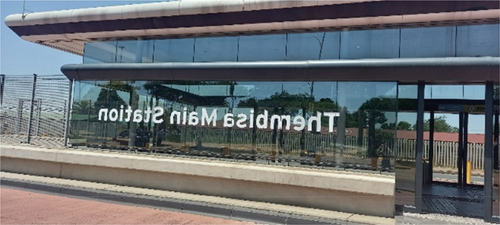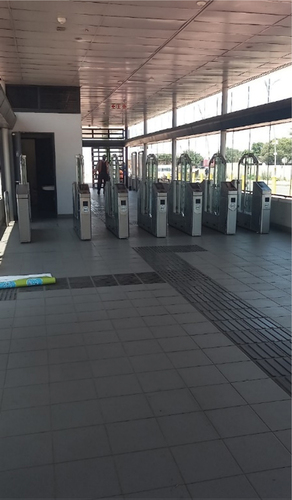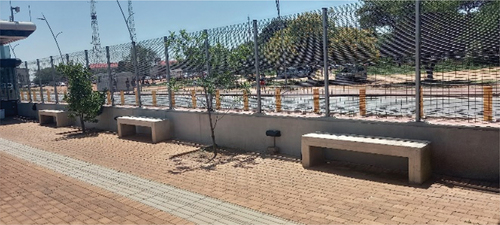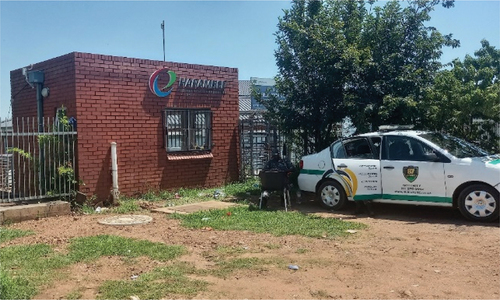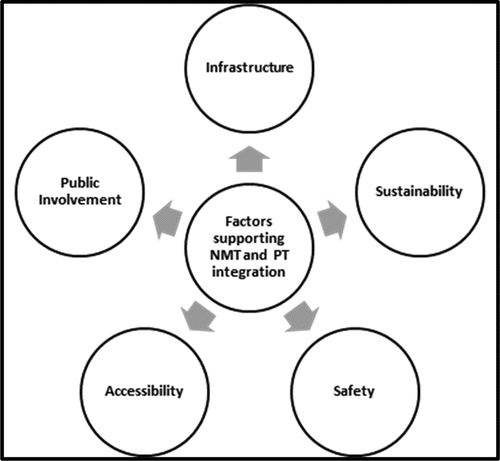ABSTRACT
South Africa is considered an economically progressive country, meaning it is slowly exiting the third world and transitioning towards the developing world. With this comes many challenges, some rooted in transportation. Around 80% of South Africans solely rely on public transportation (PT) and are dependent on private minibus taxis. There is little knowledge and evidence on the fluidity and integration of motorised transport systems with non-motorised transport (NMT) in South Africa. Consequently, this work assessed the implementation of NMT and PT in Ekurhuleni. The study adopted a case study research design by analysing the Harambee BRT through a qualitative approach using desktop studies and semi-structured interviews with key informants involved in the project. The work identified five aspects of accessibility (application of the inclusive cities paradigm), safety (sufficient lighting, signage and frequent patrolling by law enforcement), infrastructure (Information and Communications Technology (ICT), walkways, pedestrian bridges, dedicated bus lanes, paving, and tact tiles, universal design principles and an Ekucard system), sustainability (promoting healthier lifestyles and the cost effectiveness of the transport system) and public involvement as the core elements which created a model that needs to be implemented in future projects in order to effectively integrate NMT and PT.
Introduction
South Africa is considered an economically progressive country, meaning it is slowly exiting the third world and transitioning towards the developing world (Laurie et al., Citation2015, p. 962). Due to the transition, there are many challenges, several of which are rooted in transportation. For example, around 80% of South Africans solely rely on public transportation (PT) and are dependent on private minibus taxis (Okoro & Musonda, Citation2019, p. 2). These transport methods are usually overcrowded and expensive for those travelling from townships and the outskirts of cities. People travelling from these areas are subject to transport costs amounting to as much as 30% of their monthly incomes (Republic of South Africa, Citation2018). Furthermore, the provision of space for non-motorised transport (NMT) is limited, as they lack safety, conflict with design patterns, have an unsupportive political environment and an inadequate infrastructure (Okoro & Musonda, Citation2019, p. 2).
When it comes to multimodal transport systems (which include public transportations such as busses, trains, etc) in South Africa being integrated with NMT, there is a lack of proper planning practice in terms of the fluidity of the two modes (Labuschagne & Ribbens, Citation2014, p. 192). Therefore, there is a need to analyse current public transport systems which have looked to integrate NMT into the overall design. By carrying out an analysis, it will provide insight into measures taken to integrate the two systems on the end of the provider for the users.
This study starts of by investigating the motivation behind the implementation of the Harambee BRT, it then goes on to analyse whether or not the aims set out were achieved and concludes by creating a model which contains the key aspects required when creating an integrated NMT and PT system using results obtained from the Harambee BRT and NMT project.
Conceptual synopsis
The literature below examines the various modes of transport analysed and the integration of the NMT and PT which serves as a backdrop for this study.
Non-motorised transport
All urban motorised trips (private and public) are multi-modal, in the sense that there is some sort of walking involved to and from the ‘main’ mode of transport, which is usually public transportation and private vehicles. The difference is that this trip to and from private vehicles is almost negligible as it costs nothing and is very short due to the fact that there is ample parking fairly close to the desired destination of users. This is why the majority of vehicle users continue to use private motorised transportation (Ortegon-Sanchez & Hernandez, Citation2016: 3–4; Mao et al., Citation2016).
Nevertheless, NMTs can be very useful in short trips as they have a lower environmental impact (Ortegon-Sanchez and Hernandez 2016: 3–4). NMTs include any form of transport that is not motorised such as walking, cycling, skating, animal drawn and so forth (Selala & Musakwa, Citation2016: 587–588). NMT also allows for users to have workable times and routes that suit them.
Walkability
The modest definition of walkability by Vargo, Stone & Glanz (Citation2012: 89) is, ‘those qualities of the built environment that encourage walking behaviors’. Vargo, Stone & Glanz (Citation2012: 89), have confidence that walkability is influenced by three components, which are density, land use and connectivity. They trust that walkability can be measured using just two components which are in relation to proximity and those linked to connectivity of several land uses. Walkability can, however, focus less on walking behaviour and more on the prospect to walk. Reducing the distance and time to public transport is seen as an integral part of users’ decisions, with other aspects such as safety, appeal of routes, short wait times at stops and infrastructure of paving being important to users (Ramos-Santiago, Citation2022).
Cycling
NMT planning in South Africa is usually scarce, as ‘decision makers’ are more focussed on providing for the larger mass of motorists, even though there are NMT policies in place (Mokitimi & Vanderschuren, Citation2017: 4807–4808; Barendse, Citation2016). Although cycling does form a part of one of the key NMTs used in South Africa, it is for recreational purposes (Selala and Musakwa Citation2016: 587). One of the main obstacles to cycling being used by the majority of South Africans would be that many do not own bicycles (Selala and Musakwa Citation2016: 587).
Motorised transport
According to Law Insider (Citation2022), motorised transportation is, ‘a vehicle capable of self-propelling, including but not limited to cars, trucks, motorhomes, off-highway vehicles (OHV), and class II and III electric bicycles’. The transport sector is reliant on motorised vehicles which has led to the transport sector being the highest contributor to congestion and GHG. Consequently, the transportation sector has been re-aligned, with new policies and guidelines to remedy this situation. Most of these ‘solutions’ were and are focussed around mass transit systems which commonly involve trains, buses and minibus taxis, rail-based Mass Rapid Transit (MRT) and Bus Rapid Transit (BRT) which fall under public transportation (Rahman, Citation2013: 1–2; Klopp et al., Citation2019).
Public transport
Public transport in urban areas has gained much importance of late due to its role in aiding sustainability and the overall quality of urban life. The effective use of public transportation has the opportunity to improve the movement of resources as well as mass mobility in cities (Saif, Zefreh & Torok, Citation2018: 36; Miller, Citation2014). Population growth in developing cities has risen exponentially, and this has created a high demand for mobility. Therefore, an appropriate transport infrastructure is necessary in order to meet the high demand of mobility and if this is lacking, it leads to long waiting times and traffic congestion in both public transport and streets. However, one way to make public transport more efficient and effective, is by improving transport services and by providing ‘Door to door mobility’ (Saif, Zefreh & Torok, Citation2018: 36; Jørgensen et al., Citation2019). Bus Rapid Transit (BRT)
Recently, BRT systems (a mode of bus) are increasingly being implemented around the world. One of the most distinctive characteristics of a BRT is a bus service with a limited number of stops. The use of information and communications technology tools are commonly incorporated into BRT systems, though this is not a necessity for BRT systems. These include tools such as, ‘bus tracking through GPS, smart cards, traffic signal priority, and electronic bus arrival time displays on board buses and at bus stands’ (Cervero, Citation2013; Wirasinghe et al., Citation2013, p. 2). BRT systems provide speed and capacity, with increased reliability through dedicated bus lanes which reduce the amount of space on roadways available for private vehicles. BRT systems have accomplished much, like other high-frequency transit modes, in attracting private vehicle users and overall reducing private vehicle use, which in turn has environmental, economic and social benefits (Trubia et al., Citation2020; Wirasinghe et al., Citation2013, p. 2).
According to Diaz & Schneck (Citation2000: 1730), these are the core elements of a BRT system:
Running ways/guide ways
Vehicles
Stations
Fare collection systems
Operations control systems
Passenger information systems
Integrated NMT and public transport
The integration of NMT with public transport makes travelling more convenient for those using public transport. below shows how the relationship between motorised transport and NMT work hand in hand with NMT being utilised from home (origin) to public transport, then from public transport to the destination of the user. This allows for a seamless trip (Cele, Citation2018; Mbatha & Gumbo, Citation2022, p. 605).
Figure 1. NMT and motorised transport integration (Mbatha & Gumbo, Citation2022, p. 605).
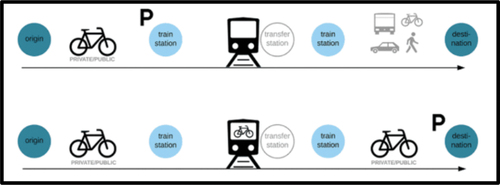
Integrated transport systems can prove to be very fruitful for users. For example, bus and rail system timetables can be synchronised such that one mode effortlessly feeds into the next. These systems have existed for some time, and work well, as both modes have strict schedules which enables users to switch from one mode to the next without long wait times. When there are delays with public transport methods, it makes the use of NMT all the more viable, efficient and attracts more users (Mbatha & Gumbo, Citation2022, p. 605).
Methods and tools
The research study used a qualitative research approach as it gave the study a more complete understanding of the research problem (Fraenkel et al., Citation2012, p. 557). Desktop studies through the perusal of journal articles and theses all pertaining to transportation planning. Infrastructure and management in South Africa and globally were used as a secondary data source. These were accessed using numerous sites such as Sage, Elsevier, and ScienceDirect. These desktop studies formed part of a literature review which contained various concepts. Data collection for this study took place between the 6th of June 2022 to the 31 August 2022. The research instruments that were used to collect data for this study were stakeholder interviews.
above is the study area of Ekurhuleni Municipality and it illustrates the Harambee BRT routes. Purposive sampling was used to select participants for stakeholder interviews. The sample size was four participants who were directly involved in the Harambee BRT and NMT project at different phases of construction. Semi-structured, open-ended interviews allowed stakeholders to elaborate on their responses and the researcher could ask follow-up questions (Fraenkel et al., Citation2012, p. 448). The stakeholders for these interviews were officials from the Transport and Fleet Department of the City of Ekurhuleni, key role-players at the Harambee BRT and an official at the Gauteng Department of Roads and Transport. The stakeholders were chosen based on the relevance of their roles to NMT provision and public transport. The interviews took place online (e-mail), based on the COVID-19 pandemic and interviewees’ personal time constraints and were then transcribed. The data collected from these interviews focused on the motivation for the introduction of NMT, the aims set out and whether or not they have been achieved since the project was introduced.
Figure 2. Current Harambee route (Harambee BRT, Citation2021).
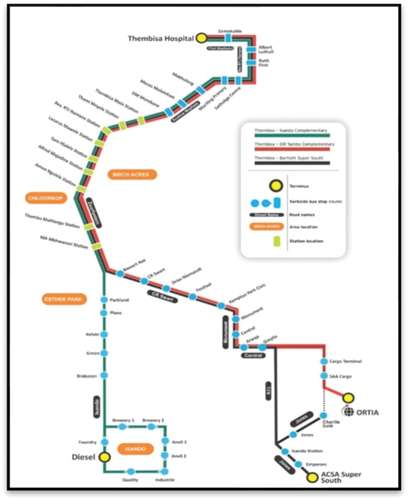
The study used two different forms of data analysis. Firstly, content analysis broke down secondary data giving the study a depth of detail. Secondly, the study adopted a thematic analysis which identified emergent themes found during stakeholder interviews through the use of coding. Content analysis was used to review literature which enabled insight to be gained about theories, concepts and precedents with regards to NMT integration with public transportation. This ensured that results from both the surveys and stakeholder interviews had sufficient literature to fall back on which provided a context for the study. Themes around the motivation of the Harambee BRT NMT infrastructure, goals and what has been achieved were explored. These themes aligned with the main objectives of the study and enabled answers to be obtained about the main research question which is the feasibility of NMT with the Harambee BRT.
Results
The results below break down the goals of the Harambee BRT and NMT as well as the various aspects that were implemented in order to create a more integrated system. The achievements, challenges and future improvements were also investigated.
Stakeholder interviews
There were four stakeholders that were interviewed based on the required information. Conversations took place via e-email as all participants did not have availability for face-to-face interviews.
Target group
The main target group for the BRT and NMT are the City of Ekurhuleni community/residents and the general public. Respondent 2 further elaborates the target group being:
Working people, scholars, people with disabilities.
The economic level targeted for both the BRT and NMT according to respondent 1 is:
Low- and middle-income earners, travelling between the CBD and townships.
Goals of the Harambee BRT and NMT
The goals of the Harambee BRT which were set out are listed below and thereafter the achievements made to date are examined.
Goals set out
The main goals that the Harambee BRT and NMT set out according to respondent 2 is:
To connect people with their jobs, schools, families and many more in a safe and cost-effective way. And connect all in the Metro into one unified City.
According to respondent 4, the NMT needed to be accessible to all:
It hoped to accommodate everyone including people that are physically impaired and elderly people.
Respondent 1 reiterates this by stating:
A system that provides people with a quicker, cheaper option mode of transportation facility.
The implementation of the Harambee BRT and NMT fell under specific requirements that needed to be met by the city. Respondent 4 further elaborated on this point:
This is part of the requirements that are a result of the Public Transport Strategy and Action Plan of 2007 that was approved by Cabinet for the implementation by the selected Cities then. Also, to achieve an integrated public transport system that is aligned to the Public Transport strategic objectives of the City.
Achievements
All participants believe that the goals set out were achieved. The Harambee BRT and NMT are however still in the construction phase. Respondent 2 goes on to explain:
Ekurhuleni BRT is still in construction for Phase 1 of the project, to date infrastructure that has been provided is proving to be effective and beneficial to the commuters, the goals were and are continuously being achieved as the project progresses.
Therefore, the goals set out for the Harambee BRT and NMT are continuously being achieved as the project progresses.
Infrastructure provision
The NMT infrastructure design plans are compliant with the Universal Design and Universal Access (UDA) standards.
According to Respondent 4, the infrastructure provisions were:
Bus stations, Pedestrian bridges, dedicated bus lanes, stream crossings, NMT walkways, ICT infrastructure. This is part of the requirements from National Department of Transport on all Cities that are implanting IPTN’s.
Further provisions were made around pedestrian paving, for example, tact tiles were utilised to accommodate those who are visually impaired and people with disability.
The main structure of Harambee BRT Stations is provided above (). The image above is of the Thembisa Main Station, and stations have glass windows, which allow users view the inside of stations and there are sliding doors on either side of the station.
Harambee BRT stations have dedicated bus lanes outside each station. These make it easier for users at stations to board buses with ease as well as increases the safety aspect for users ().
Inside Harambee BRT stations there are bathrooms (toilets) for users and Harambee BRT staff to assist them ().
There is seating located within Harambee BRT stations for users while they wait for the BRT. There are also trees and paving in this space. However, there is no shelter located within this area ().
Ease of access
Infrastructure was provided around areas of concern, respondent 2 goes on to elaborate these areas as:
Infrastructure is located in places that is easily accessible, townships where most of commuters are residing with routes going from township to town for both working class and scholars.
The city provides infrastructure services as close as possible to the community. We strive to provide Public Transport services within a distance of 500 m from the place of residents as required by the National Department of Transport. (Respondent 4)
The overall accessibility is meant to be available to all who wish to use it. Respondent 3 reiterates this sentiment:
NMT facilities are accessible to anyone. There are no barriers to prevent anyone from accessing these facilities.
Safety
The Harambee BRT NMT designated lanes are provided with adequate signage to aid commuters. Street lighting is provided along the route of the Harambee BRT and NMT to not only increase the visibility of pedestrians but also motorist awareness. Respondent 2 elaborates on this:
Designated lanes are provided with adequate signage, 2. Street lighting provided to enhance visibility at night, public and motorist awareness, law enforcement for motorist misuse of the infrastructure.
Law enforcement are also available to protect users of the BRT and NMT:
The safety aspect is the responsibility of the Ekurhuleni Metro Police Department. (Respondent 4)
There is a security officer and patrol vehicle situated at the Thembisa Hospital Harambee BRT stop at all times ().
Public involvement
The public was very much involved in the entire project at various phases.
Studies were conducted into areas where this facility was to be constructed. Conclusion thereof was reached and recommendations on position where they are to be erected were passed. (Respondent 1)
Challenges were also one the main aspects that were looked into during the public involvement stage, respondent 2 outlines what areas around feedback was analysed:
Community surveys, public participation and meetings, are done to feedback from the community on challenges with public transport, walking/cycling and also to get feedback on what they would want to see happen.
Factors for consideration
These include the benefits and challenges when considering the implementation of the Harambee BRT and NMT.
Benefits
The benefits were listed in terms of the overall Harambee BRT benefits and the benefits of the integration of the NMT and Harambee BRT.
Harambee BRT
The Harambee BRT offers many benefits to its users, such as:
Low fare, universally accessible buses, rapid and quick bus movements, which therefore enables quicker mobility of people. (Respondent 1)
It aimed to redress situations which created inequalities in the past, respondent 3 states:
To provide the public with decent facilities and improve conditions caused by many years of neglect.
Respondent 4 further goes on to say:
It provides a good, safe, integrated and reliable public transport service to the community.
NMT integration with the Harambee BRT
The integration of the provided NMT with the Harambee BRT is essential as it acts as an enabler for pedestrian movement. It also promotes a healthier lifestyle, is cost effective and is inclusive and accessible to the general public, including those with disabilities. Respondent 2 further explains the importance of this integration:
Public transport is usually overcrowded and a bit costly for some South Africans from the townships. Having NMT infrastructure that is integrated to BRT will assist in improving safety for either people on foot or cyclists by providing adequate infrastructure (e.g. designated lanes) cyclists and pedestrians for use. It also provides commuters easy access to the public transport through walking or cycling.
Challenges
Dedicated bus lanes for the Harambee BRT are currently being used by private motorists which causes unnecessary traffic not only for the Harambee buses but other private motorists as well. Moreover, the provision of dedicated bus lanes meant that roads needed to be widened in order to accommodate the bus service:
The Implementation of bus lanes and street widening in some areas displace pedestrian paths and cyclists’ lanes. (Respondent 2)
The IRPTN project’s main challenge was however rooted in the implementation phase noted by respondent 4:
The slow implementation of the IRPTN project and prolonged negotiations with the existing Public Transport operators.
Possible improvements
A way to improve the current services would according to respondent 3 is through the:
Effect continuous improvement measures based on audits, new standards, inputs from the general public.
Through ad hoc creation of awareness to both motorists and pedestrians using the infrastructure. (Respondent 1)
Respondent 4 further goes on to say:
The service can be improved by being integrated with other Modes of Transport, including other BRT services that are implemented by the neighbouring Municipalities to the City of Ekurhuleni.
The City of Ekurhuleni is still progressively implementing the project, including the NMT infrastructure, with the plan of extending this service to Vooslorus in the near future.
Discussion
The discussion below further analyses stakeholder interview results in terms of the factors supporting the Harambee BRT NMT.
Accessibility
One of the Harambee BRT NMT project aims was to provide accessible infrastructure that was not only accessible to the general public but also to the elderly and those with disabilities. The project also aimed to provide a system which allowed people to be transported faster at cheaper prices. The inclusive cities paradigm proposes universal access for all which means that every person should have a right to go wherever they want whenever they want to. Therefore, provisions need to be made in order for this to be possible (Orellana et al., Citation2020, p. 3).
Safety
The two aspects that the Harambee BRT NMT set out to achieve in terms of safety were around signage and lighting to protect NMT users and motorists and around the frequent patrolling of law enforcement. A study by Becker (Citation2011, pp. 9–10) identifies users’ protection from crime and safety in terms of protection from accidents or injury (motorised vehicles harming NMT users or the use of poor NMT) as the core components of safety around the use of NMT. Therefore, the implementation of lighting and relevant signage can be seen in all Harambee BRT NMT images.
Infrastructure
The Harambee BRT NMT used Universal Design and Universal Access standards to ensure that the design, ICT infrastructure, walkways, pedestrian bridges, stream crossings, dedicated bus lanes, paving and tact tiles all met the terms of the National Department of Transport. The Harambee BRT has an Ekucard system in place where users can load money onto their cards and tap in when they get onto Harambee BRT buses making the integration of NMT and public transport effortless (Mbatha & Gumbo, Citation2022, p. 605). This system is cashless, although users can also buy tickets at stations. The majority of users find this system useful as it is safer and more convenient, while others either find it difficult to load money onto these cards or forget to load money on them causing even greater inconvenience to the user. A study conducted in South Africa showed much support of cashless payments as many users have smartphones, however, infrastructure to support this, and the integration of bank accounts are imperative to not only the success of the system but overall user adoptability in the long run (Schalekamp et al., Citation2017).
Sustainability
Two aspects of sustainability that were focused on when implementing the Harambee BRT and NMT were promoting a healthier lifestyle (of both users and the environment) and cost effectiveness. These types of measures fall under ‘positive sustainability’ as they actively promote and improve the quality of life of users (James & Magee, Citation2016, p. 3). Both promoting a healthier lifestyle and the cost effectiveness of using the Harambee BRT NMT supports the SLA as users are less likely to be susceptible to environmental, social and economic ‘stresses’ (Morse & McNamara, Citation2013, p. 17).
Factors for consideration
The factors for consideration when implementing the Harambee BRT and NMT are analysed below in terms of the benefits and challenges.
Benefits
The benefits of the Harambee BRT include lower fares, decent public transport facilities, universally accessible buses and a rapid movement system which allows faster mobility of people making it quite dependable and consistent (Matubatuba, Citation2020). The benefits of the Harambee BRT NMT are that it is an integrated transport system which is easily accessible to all, promotes healthier living, is cost effective, improves safety of users and provides easier access to public transport.
Challenges
Dedicated Harambee BRT lanes are being used by other motorists which causes traffic congestion for Harambee BRT buses and other motorists, and as BRT lanes were built, roads needed to be widened which displaced pedestrian and cycle lanes. The main challenge was around the slow implementation of the project owed to lengthy negotiations with existing public transport operators leading to the high costs of implementing a project of such a magnitude.
Goals
Below is a breakdown of the goals which were set out to achieve when implementing the Harambee BRT and NMT. It further goes on to outline the goals, which have been achieved to date.
Goals set out
The goals set out for the Harambee BRT and NMT were not only around connecting the city, but the effective and efficient transportation of people to work and other places such as schools, their families, etc. in a safe way. The system needed to be cost effective and quicker. The project was a part of the Public Transport Strategy and Action Plan of 2007 which was a requirement for the implementation of an integrated public transport system. The Department of Transport has recently implemented a Revised Strategic Plan 2020/21–2024/25, which looks to increase the number of hours that BRT’s will run with a baseline of 16 hours per day and a goal of 20 hours per day, which will provide users with better access to public transport during hours, which may have been difficult for users to travel (Department of Transport Revised Strategic Plan, Citation2021).
Goals achieved
All stakeholders believe that the goals set out were achieved. However, participants emphasise that the Harambee BRT and NMT are still in the construction stage and therefore goals are being achieved as the project progresses. Despite this though, the infrastructure which is currently in place is proving to be quite beneficial to users.
Model for the successful implementation of NMT and PT integration
Using the results obtained from stakeholder interviews, a model was created for the successful implementation of NMT and PT integration.
The model above () illustrates the main aspects discovered when looking at the effective integration of NMT and PT at the Harambee BRT. These aspects are infrastructure (shelter, benches, designated lanes, etc), sustainability (reduction in private vehicles use, cleaner modes of transport use, predominantly ticketless, etc), safety (lighting, patrolling, cameras, etc), accessibility (central pick-up and drop-off points, universal design elements to include all, etc), public involvement (public input, motorist and pedestrian awareness programs, etc). By incorporating all aspects successfully, a more integrated transport system can be implemented which allow users to seamlessly shift from one mode of transport to the next.
Conclusions
The study overall found that accessibility played a major role in the implementation of the Harambee BRT and NMT, ensuring that all users are able to access and use the Harambee BRT and NMT promoting inclusivity. The safety considerations of the Harambee BRT and NMT included the two aspects of lighting and signage. Infrastructure implementation was around ICT infrastructure, walkways, pedestrian bridges, dedicated bus lanes, paving and tact tiles, universal design principles and an Ekucard system. The two aspects considered when looking at sustainability are promoting healthier lifestyles and the cost-effectiveness of the system. After uncovering the core aspects required when implementing such a project, a model was created for executing future projects of this nature. Therefore, accessibility, infrastructure, safety, sustainability and public involvement are identified as factors aiding in the integration of public transport and NMT. Further research on user experiences on the integration of the BRT system and the provided NMT should be analysed to give further insight into what actual users prefer and the shortcomings and successes of the systems.
Acknowledgments
The Ekurhuleni Municipality and Harambee BRT operators.
Disclosure statement
No potential conflict of interest was reported by the author(s).
References
- Barendse, C. J. (2016). Enhancing integrated transport planning: A spatial multi-criteria analysis approach to the MyCiTi integrated rapid transit system, South Africa. Retrieved May 6, 2024, from. http://hdl.handle.net/11427/24444
- Becker, T. (2011). Obstacles for non-motorised transport in developing countries-a case study of Nairobi, Kenya. European Transport Conference 2011Association for European Transport (AET) Transportation Research Board. Retrieved November 29, 2022, from https://trid.trb.org/view/1258643
- Cele, N. G. P. (2018). Non-motorised transport as a key element of an integrated rapid public transport network: The cato manor case [ Unpublished Master’s Dissertation]. University of South Africa. Retrieved May 5, 2024, from https://www.academia.edu/download/89423414/343122782.pdf
- Cervero, R. (2013). Bus rapid transit (BRT): An efficient and competitive mode of public transport. Retrieved May 5, 2024, from https://escholarship.org/uc/item/4sn2f5wc
- Department of Transport Revised Strategic Plan for the fiscal years 2020/21 – 2024/25. (2021). Retrieved May 2, 2024, from https://www.transport.gov.za/wp-content/uploads/2023/06/Approved_Revised_StrategicPlan_2020_2025_20052021.pdf
- Diaz, R. B., Schneck, D. C. (2000). Bus Rapid Transit Technologies in the Americas: An Overview. Journal of the Transportation Research Board, 1731(1), 3–17. https://doi.org/10.3141/1731-01
- Fraenkel, J. R., Wallen, N. E., & Hyun, H. H. (2012). How to design and Evaluate Research in education (Vol. 7, p. 429). McGraw-Hill. Retrieved August 22, 2022, from https://saochhengpheng.files.wordpress.com/2017/03/jack_fraenkel_norman_wallen_helen_hyun-how_to_design_and_evaluate_research_in_education_8th_edition_-mcgraw-hill_humanities_social_sciences_languages2011.pdf
- Harambee BRT. 2021. Current Harambee Route. Retrieved December 13, 2021, from, ht tps://do i.orgharambeebrt.co.za/routes/
- James, P., & Magee, L. (2016). Domains of sustainability. In Global encyclopedia of public administration, public policy, and governance (pp. 1–17). Springer International Publishing. Retrieved August 23, 2022, from https://www.researchgate.net/profile/Paul-James-20/publication/313794820_Domains_of_Sustainability/links/5a9e3c820f7e9bc35fcfde1b/Domains-of-Sustainability.pdf
- Jørgensen, B. H., Andersen, K. K., & Nielsen, O. A. (2019). Transforming urban mobility: Key findings and recommendations. DTU international energy report 2019-transforming urban mobility (pp. 8–11). Retrieved May 3, 2024, from https://backend.orbit.dtu.dk/ws/portalfiles/portal/201072364/1_chp.pdf
- Klopp, J. M., Harber, J., & Quarshie, M. (2019). A review of BRT as public transport reform in African cities. VREF Research Synthesis Project Governance of Metropolitan Transport, 30. Retrieved May 4, 2024, from https://www.researchgate.net/profile/Jacqueline-Klopp/publication/333971452_A_REVIEW_OF_BRT_AS_PUBLIC_TRANSPORT_REFORM_IN_AFRICAN_CITIES/links/5d1031a0299bf1547c795056/A-REVIEW-OF-BRT-AS-PUBLIC-TRANSPORT-REFORM-IN-AFRICAN-CITIES.pdf
- Labuschagne, F., & Ribbens, H. (2014). Walk the talk on the mainstreamimg of non-motorised transport in South Africa. Retrieved December 8, 2022, from https://repository.up.ac.za/handle/2263/45524
- Laurie, S., Faber, M., Adebola, P., & Belete, A. (2015). Biofortification of sweet potato for food and nutrition security in South Africa. Food Research International, 76, 962–970. Retrieved December 11, 2021, from https://doi.org/10.1016/j.foodres.2015.06.001
- Law Insider.2022. Motorised vehicle definition. Retrieved November 29, 2022, from https://www.lawinsider.com/dictonary/motorised-vehicles
- Mao, Z., Ettema, D., & Dijst, M. (2016). Commuting trip satisfaction in Beijing: Exploring the influence of multimodal behavior and modal flexibility. Transportation Research Part A: Policy and Practice, 94, 592–603. Retrieved May 6, 2024, from https://doi.org/10.1016/j.tra.2016.10.017
- Matubatuba, R. (2020). Determinants of consumer adoption of the Rea Vaya (BRT) system in Johannesburg. University of Johannesburg (South Africa). Retrieved May 6, 2024, from https://www.proquest.com/openview/fa99e280a6b9acd2808ccd6ad9953c3d/1?pq-origsite=gscholar&cbl=2026366&diss=y
- Mbatha, S., & Gumbo, T. (2022, November). Possibilities of integrating motorised transportation and non-motorised transportation in the city of Johannesburg. Mobility, Knowledge and Innovation Hubs in Urban and Regional Development. Proceedings of REAL CORP 2022, 27th International Conference on Urban Development, Regional Planning and Information Society (pp. 603–613). CORP–Competence Center of Urban and Regional Planning. Retrieved November 28, 2022, from https://archive.corp.at/cdrom2022/papers2022/CORP2022_118.pdf
- Miller, P. (2014). Sustainability and public transportation theory and analysis [ Doctoral dissertation]. University of Calgary. Retrieved May 3, 2024, from https://prism.ucalgary.ca/server/api/core/bitstreams/8d010144-07fa-4293-810c-251c67fb0bca/content
- Mokitimi, M. M., & Vanderschuren, M. (2017). The Significance of Non-Motorised Transport Interventions in South Africa - A Rural and Local Municipality Focus. Transportation Research Procedia, 25, 4798–4821. https://doi.org/10.1016/j.trpro.2017.05.491
- Morse, S., & McNamara, N. (2013). Sustainable livelihood approach: A critique of theory and practice. Springer Science & Business Media. Retrieved April 27, 2022, from https://books.google.co.za/books?hl=en&lr=&id=PQ5HAAAAQBAJ&oi=fnd&pg=PR3&dq=Morse,+S.+and+McNamara,+N.+2013.+Sustainable+livelihood+approach:+A+critique+of+theory+and+practice.+Springer+Science+%26+Business+Media+&ots=Bw7kBo8VKE&sig=df9CVc5RZS-muq8G4o5zdXfSk6E&redir_esc=y#v=onepage&q=Morse%2C%20S.%20and%20McNamara%2C%20N.%2C%202013.%20Sustainable%20livelihood%20approach%3A%20A%20critique%20of%20theory%20and%20practice.%20Springer%20Science%20%26%20Business%20Media&f=false
- Okoro, C., & Musonda, I. (2019). Planning considerations for smart and sustainable transportation infrastructure: Case study of non-motorised transport facilities in Johannesburg South Africa. Planning, 17, 21. Retrieved December 14, 2021, from https://ujcontent.uj.ac.za/vital/access/services/Download/uj:32957/SOURCE1
- Orellana, D., Bustos, M. E., Marín-Palacios, M., Cabrera-Jara, N., & Hermida, M. A. (2020). Walk’n’roll: Mapping street-level accessibility for different mobility conditions in Cuenca, Ecuador. Journal of Transport & Health, 16, 100821. Retrieved August 19, 2022, from https://doi.org/10.1016/j.jth.2020.100821
- Ortgeon-Sanchez, A., & Hernandez, D. O. (2016). Assessment of the potential for modal shift to non-motorised transport in a developing context: Case of Lima, Peru. Research in Transport Economics, 60, 3–13. https://doi.org/10.1016/j.retrec.2016.05.010
- Rahman, M. (2013). Planning for sustainability of non motorised public transport in a developing city. Queensland University of Technology. Accessed May 11, 2024, from https://eprints.qut.edu.au/6359/1/Mamun_Rahman_Thesis.pdf
- Ramos-Santiago, L. E. (2022). Does walkability around feeder bus-stops influence rapid-transit station boardings? Journal of Public Transportation, 24, 100026. Retrieved May 2, 2024 https://doi.org/10.1016/j.jpubtr.2022.100026
- Republic of South Africa. (2018). Non-motorised transport - South Africa. Retrieved December 14, 2021, from https://www.dffe.gov.za/projectsprogrammes/nonmotorisedtransport_southafrica
- Saif, M. A., Zefreh, M. M., & Torok, A. 2019. Public Transport Accessibility: A Literature Review. Periodica Polytechnica Transportation Engineering. Retrieved May 11, 2024, from htt ps://do i.org/pp.bme.hu/tr/article/view/12072
- Schalekamp, H., Mclaren, M., & Behrens, R. (2017). Exploring cashless fare collection in the context of urban public transport reform in South Africa. Southern African Transport Conference. Retrieved May 2, 2024, from http://hdl.handle.net/2263/62743
- Selala, M. K., & Musakwa, W. 2016. The potential for Strava Data to contribute in non-motorised transport (NMT) planning in Johannesburg. The International Archives of Photogrammetry, Remote Sensing and Spatial Information Sciences. Retrieved June 16, 2022, from https://doi.org/10.5194/isprs-archives-XLI-B2-587-2016
- Trubia, S., Severino, A., Curto, S., Arena, F., & Pau, G. (2020). On BRT spread around the world: Analysis of some particular cities. Infrastructures, 5(10), 88. Retrieved May 6, 2024, from https://doi.org/10.3390/infrastructures5100088
- Vargo, J., Stone, B., & Glanz, K. 2012. Google Walkability: A New Tool for Local Planning and Public Health Research. Journal of Physical Activity and Health, 9(5), 689–697. https://doi.org/10.1123/jpah.9.5.689
- Wirasinghe, S. C., Kattan, L., Rahman, M. M., Hubbell, J., Thilakaratne, R., & Anowar, S. (2013). Bus rapid transit–a review. International Journal of Urban Sciences, 17(1), 1–31. Retrieved May 5, 2024, from https://doi.org/10.1080/12265934.2013.777514

